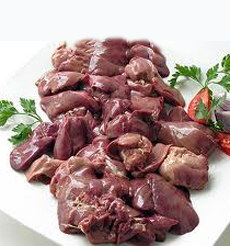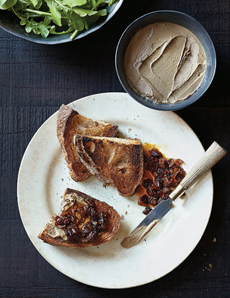Chicken Liver Pâté Recipe
|
Here’s a treat for everyone who loves pâté but can’t afford the duck and goose versions; as well as those who won’t eat their enlarged livers due to animal welfare concerns.*
This chicken liver pâté recipe, sent to us by the New York Times to share, was published in the January 26th Sunday Magazine section. It is gourmet Super Bowl fare or a spread for any party or special occasion. (Why a special occasion? The cholesterol!) Not only is chicken liver pâté a luxurious spread; it is affordable and quick and easy to prepare. Here’s the full article. The concept dates back centuries if not millennia. In modern times, there’s a similar recipe in Julia Child’s Mastering The Art Of French cooking. Our grandmother and her grandmother made a Jewish version; her fat of choice was schmalz (rendered chicken fat, discussed below)—no butter or cream—yellow onions instead of shallots, no wine. Nana’s tip: Don’t overcook the livers—the insides should still be pink. |
|
|
|
________________
*The issue of whether or not gavage, the force-feeding of ducks and geese to enlarge their livers, is complex and is not discussed here. You can serve chicken liver pâté in a crock with toast or crackers and a side of bacon jam (make this recipe or buy ready-made bacon jam like Skillet Bacon Spread. (Here’s our review; you can buy it on Amazon.com).
|
||
 Raw chicken livers. Photo courtesy Anu Shoj | Anu’s Healthy Kitchen | Blogspot. Check out her recipe for fried chicken livers. |
RECIPE: CHICKEN LIVER PATÉ You can make this recipe in 20 minutes, plus a couple of hours to chill in the fridge. Ingredients For 6-8 Servings |
|
|
Preparation 1. HEAT a large, heavy sauté pan over medium heat and melt 4 tablespoons of the butter until it begins to foam. Add the shallots and sauté until translucent, taking care not to brown. 2. ADD the livers, thyme, and Madeira or Port, and turn the heat to high. Cook, occasionally stirring the livers with a spoon, until the wine has reduced and the livers are lightly browned but still very soft and pink on the inside—approximately 5 minutes. 3. REMOVE the pan from the stove, and transfer the contents into a blender or food processor, along with the cream and the remaining butter. Purée until smooth, adding a little more cream if necessary. Taste and adjust seasoning, adding salt if necessary. 4. PACK the pâté into a glass jar or bowl, then smooth the top with a spatula. Cover with plastic wrap and refrigerate until firm, about two hours or up to five days. Serve with bacon-onion jam and copious amounts of toast. Schmaltz, also spelled schmalz or shmalz, is rendered (clarified) chicken or goose fat. It is used both for cooking and as a spread on bread in Ashkenazi Jewish cuisine (Austria, Germany and Poland, and other Northern European countries). The term is Yiddish, derived from the German Schmalz, meaning “rendered animal fat.” While both tallow and lard are forms of Schmalz in German, as is clarified butter, in English the term follows the Yiddish use, referring to fat rendered from poultry. Schmaltz was an important fat in the lives of European Jews, who were forbidden by Kosher dietary laws from combining meat and dairy products. They could not use butter in meat dishes, and of course, could not use pig-based lard. So in order to cook meat and poultry dishes or the sides served with them (potatoes, for example), schmaltz or vegetable cooking oil was required. It was also used to butter bread. The impact on cardiovascular health has become an issue in the last 40 to 50 years. CHECK OUT WHAT’S HAPPENING ON OUR HOME PAGE, THENIBBLE.COM.
|
||



